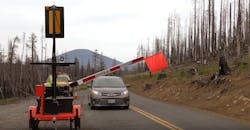Oregon DOT using new auto flagging technology to protect road workers
The Oregon DOT (ODOT) has begun deploying new automated flagging technology—automated flaggers—that takes work-zone flaggers out of the line of traffic in order to make them safer.
Every year flaggers and other highway workers are injured and killed on highways in Oregon and across the nation.
An auto flagger is a device with lights and a flagging arm. Auto flaggers are more visible to drivers than traditional flaggers and allow a person to operate the device at a safe distance from traffic. A flagger still operates the auto flagger—they are just positioned outside the line of traffic and away from the hazards of oncoming vehicles approaching the work zone.
When a motorist sees an auto flagger, they are expected to stop when the light is red and the arm is down, proceed with caution when the light flashes yellow and the arm is up, and know that there is, in fact, someone nearby operating the device.
According to ODOT, 90% of Oregon work-zone crashes are caused by bad driving such as drivers following too close, driving too fast, not yielding, or driving under the influence. The department is urging drivers to pay attention to work zone signs, slow down in work zones, and obey all flaggers.
---------
NEWS & IMAGE SOURCE: Oregon DOT
